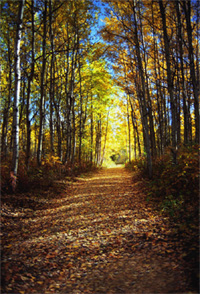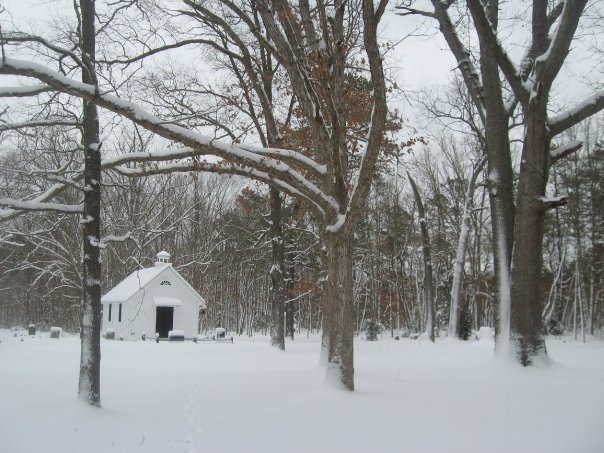Today SevenPonds speaks with Ed Bixby, owner and operator since 2007 of Steelmantown Cemetery Green Burial Preserve in New Jersey. He is also the Vice-President of Green Burial Council International. Steelmantown Cemetery Green Burial Preserve is the only cemetery in the State of New Jersey certified and approved by the Green Burial Council as a Level 3 Natural Burial Ground. In the first half of his two-part interview, Ed discusses the services the cemetery provides, what sparked his interest in natural burial, the natural burial process and how it differs from traditional burials.
Zoë: What is Steelmantown Cemetery? What are some of the services you provide?
Ed: We are the only woodland burial preserve in South New Jersey. We are one of the busiest preserves in the country and service people from New York and other Eastern states in addition to New Jersey. Steelmantown doesn’t resemble the traditional cemetery. We are adjacent to the 25,000-acre Belleplain State Forest. When you come, you can walk the trails. We have naturalist educators on staff. We offer burials off our trail. Everything blends in. You wouldn’t even notice you’re in a cemetery. The cemetery itself dates back to 1700. My family came in 1680 and owned 195,000 acres in quote modern-day Atlantic City area. The original burial site was one acre. Until 1840, the cemetery was a private cemetery. From 1840-1957, it was a public cemetery. From 1957 to 2007, it was private again.
When you come, you can walk the trails. We have naturalist educators on staff. We offer burials off our trail. Everything blends in. You wouldn’t even notice you’re in a cemetery.
Since 2007, when I became the owner, it has been public. We offer woodland burials and cremations in our trails as well as in the small remaining sections of our historic plots. To be considered a natural burial: no embalming fluid can be used; no concrete vaults can be used. We use burial shrouds, such as pine and wicker caskets as well as biodegradable caskets. Our burial sites are dug by hand and mark them with natural stones. These are the big deciding factors between our place and traditional cemeteries. Our cemetery is to be enjoyed by everyone, especially those mourning the losses of loved ones. It’s a happy place. Nobody can truly enjoy a natural burial until they’ve experienced one. My definition of a natural burial besides the environmentally sensitive part is that our goal is to empower the families.
When you come to my cemetery, you can participate in everything. Natural burials are one of those cathartic experiences. People show up crying and grief-stricken and leave with smiles. Getting a hands-on experience really helps the grieving process and lets you celebrate the life of the loved one you lost. Natural burial is a real moving experience for those grieving. People are so used to the traditional funerals with funeral directors having all of the control, where you’re more of a spectator and you’re getting in and out of cars between the service and the burials. How does that help the grieving? Every single natural burial at my cemetery creates a life-changing bond. I know every single family I’ve helped. You want people to be happy with their choices in life, so they’ll come back. It has become a passion of mine to help people in need.
Zoë: Were you always interested in natural burial?
Ed: No, not at all, not for any particular reason. The cemetery had been a family cemetery for my family. It was sold from my family to a funeral director in 1957 for ironically “natural burial.” This funeral director buried mentally disabled boys and men from the state school—just dug up the graves and buried them. My own brother was the last family member to be buried there in 1956. My mother was always bothered by and had a heavy heart by this burial. She wanted to retrieve him from there, but he was buried in a wicker basket and it would be pretty impossible to find. I’m a developer with my own realty company. I went to check out the cemetery again for the first time in several years. It had fallen into disrepair. The chapel had been burned and vandalized. There was lots of trash. I told the owner, Jack, he needed to fix it up and he said he wasn’t able to do so. He then made an interesting proposition to me that he’d give me the cemetery if I were interested. I thought, “Somebody needs to be responsible.” At first, I thought I would be just the caretaker. I didn’t think there was any life left in it. My dad and I cleaned it up.
Two to three months later, I read an article in The Atlantic City Press about natural burial that listed five prerequisites. I learned that we met every single prerequisite, so I contacted Green Building Council to become certified. It is the only cemetery in the State of New Jersey certified and approved by the Green Burial Council as a Level 3 Natural Burial Ground. The previous owner had given me a piece of paper with a handwritten survey of the land and I talked to a surveyor. It turns out the cemetery was a lot bigger than Jack had originally thought, so I bought the adjacent property and expanded the cemetery. I did what I felt was right. I think I think a little outside the box. You can’t box or recreate this. It just has to be.
I thought, “Somebody needs to be responsible.” At first, I thought I would be just the caretaker. I didn’t think there was any life left in it. My dad and I cleaned it up.
I didn’t know how passionate I was until my first funeral. The masons who built the foundation were the gravediggers. Seeing the tears of the grieving loved ones really brought it home for me. I didn’t choose this profession. It chose me. A lot of people tell me I’m a pioneer, which I find a little ridiculous. Without really practicing natural burial, you can’t really understand it. That is why I’m so open to sharing about it. I’ve inspired four people to be funeral directors, which is pretty impressive. I’ve found a deep connection and a deeper sense of satisfaction with helping these families. I didn’t seek it. It chose me. Besides my wife and kids, it’s the best thing to happen to me.
Zoë: Could you explain to us the standard process of a natural burial?
Ed: I’ve never had a family handle the body themselves. Funeral directors serve a big role. They should be more of a facilitator. In New Jersey, bodies have to be under refrigeration or interred within 48 hours or they will have to be embalmed. A couple of years ago, we buried nothing but shroud burials, meaning in sheets, which are a very old way of burials that dates back to the days of Jesus. People also can be buried in pine and wicker caskets and other biodegradable caskets. The funeral director would set up whatever type of shroud or casket the family requests. Any kind of natural greenery and vegetation can cover the gravesite as a way to prepare and soften it. For example, in winter, we use cedar rose. A typical burial happens within three to five days as long as refrigeration is happening. In my opinion, people unembalmed look much more natural than those embalmed.
We offer the chapel for the services or the celebrations of life. 9 times out of 10, they use the chapel for parties with food to celebrate the life of the loved one they have lost. Families are allowed to use the wagon to carry their loved ones to the gravesite. Six family members get to lower their loved ones into the site. We offer people to help bury and cover the gravesite with natural vegetation. We also offer the family the chance to put natural stones to mark the graves. Services usually last two to three hours. That sounds long, but it doesn’t drag on. When you’re surrounded by wilderness with the wind whistling and the birds flying around, people don’t want to leave.
Zoë: How do natural burials differ from traditional burials?
Ed: They are more of a personal participation event. Unlike traditional funerals where you’re more of a spectator, truly you’re an actual participant when it comes to natural burial. There is no ticking clock. The family can have all the time they want. That is the real difference.
Today SevenPonds continues our two-part interview (read part one here) with Ed Bixby, owner and operator since 2007 of Steelmantown Cemetery Green Burial Preserve in New Jersey. He is also the Vice-President of Green Burial Council International. Steelmantown Cemetery Green Burial Preserve is the only cemetery in the State of New Jersey certified and approved by the Green Burial Council as a Level 3 Natural Burial Ground. In the final half of his two-part interview, Ed discusses the cost differences of a natural burial from a traditional one, a story of one the families he helped, the laws surrounding natural burial and where one can find natural burial resources.
Zoë: What are some of the cost differences between a traditional and a natural burial?
Ed: Natural burials are much more cost-efficient. A natural burial is more service-oriented than product-oriented. In my cemetery, a single plot in the historic section costs $1,500 and a double plot in the woodland area costs $3,000. If you choose to be shrouded, the cost is pretty inexpensive—around $100 to $500. The low cost is the same with biodegradable caskets, which are around $200-$1,600. Here in New Jersey, funeral directors charge around $1,500. Their three main tasks are to wash, dress and transport the bodies. If you were to buy a plot and service in my place, the total would be $2,500 to $3,000 at most. The typical traditional New Jersey/New York funeral costs $9,000 total. I’ve never had problems with the families I’ve worked with because they really want it. It’s pretty significant savings.
Zoë: Do you have any stories of people’s experiences with natural burial that you would be willing to share?
Ed: There are so many stories. My cemetery is about a two-hour drive from New York. 90% of people come from NYC. I have had funerals for people from California who were originally from the East Coast. We had a married couple—two men. One of them contracted cancer. They had lived in San Francisco and had moved to Delaware. The man with cancer, who passed away, was a Latino man in his forties and had been in the military. About 15 family members came out for the service. The gravediggers invited them to participate because they saw that everyone was pretty broken up. As part of the Latino culture, some of this man’s brothers didn’t embrace his lifestyle. I went over to one of the brothers and told him he should participate. I gave this macho man who loved his brother and lost a lot of time, for what I believe are silly beliefs, a push to do something because I saw a lifetime of regret on his face. He didn’t say anything and started participating by helping with the burial. He later thanked me for the push. It’s a hell of a place to heal wounds and to get to the point. At my cemetery, it can be done. The ability to fully participate brings people together for the right reasons, which one might not be able to do in a sterile environment like traditional funerals.
Zoë: What are the laws in regards to natural burial today?
Ed: Not a single state doesn’t allow it. Not many states regulate it. Only 10 states have regulations about it. There are not many rules or regulations against it. It’s really up to funeral directors and conventional cemeteries.
Zoë: How can people find out about natural burial resources for where they live?
Ed: I would recommend they visit the Green Burial Council’s website. The Green Burial Council is the torchbearer of the people behind this movement. If providers meet the requirements to be certified by the Green Burial Council, it means a lifetime commitment. They are a nonprofit. I warn people, “You should really do your research,” because consumers themselves should be concerned. Joe Shee, the founder of Green Burial Council, met a lot of resistance when he started it. People don’t like change. Now it’s very different. Personally, I’ve never had problems with funeral directors not respecting my work. In 2015, people are seeing natural burial as a viable option that’s not going away just like cremation is here to stay. The funeral industry is finally recognizing us. Every cemetery should consider doing this because you’re really doing a service to the community.
Zoë: Thank you for speaking with us!
Ed: No problem. I appreciate it.

 What is Natural Burial? An Interview with Ed Bixby
What is Natural Burial? An Interview with Ed Bixby







 “Briefly Perfectly Human” by Alua Arthur
“Briefly Perfectly Human” by Alua Arthur
 Neil deGrasse Tyson Prompts Ruminations on Life & Death in New Year
Neil deGrasse Tyson Prompts Ruminations on Life & Death in New Year
 “I Will Remember You” by Sarah McLachlan
“I Will Remember You” by Sarah McLachlan














